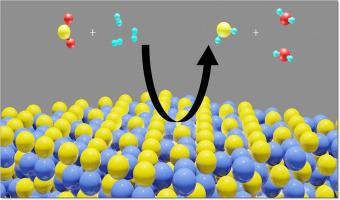Applied Surface Science ( IF 6.7 ) Pub Date : 2021-04-25 , DOI: 10.1016/j.apsusc.2021.149872 Omer Elmutasim , Muhammad Sajjad , Nirpendra Singh , Yasser AlWahedi , K. Polychronopoulou

|
Optimizing catalysts for the hydrodesulfurization (HDS) is a crucial step toward conforming with the environmental requirements concerning emissions. Nickel phosphides have been reported as efficient catalysts in HDS reaction. However, how HDS reaction proceeds on nickel phosphides is not well understood. On this context, the present work focuses on the mechanistic understanding of HDS reaction over surfaces. The adsorption of both reactants, and molecules, on low-index facets of crystal, namely (0 0 1), (0 1 1), (1 1 1), (1 1 0) , (1 0 1), (0 1 0) and (1 0 0) surfaces, were investigated using density functional theory (DFT) calculations. The stability of surfaces was examined and (0 0 1) surface was found to be the most stable surface. Therefore, microkinetic modeling was conducted on (0 0 1) surface to predict the catalytic preferred pathways. Reaction towards , main product, exhibited 100% selectivity at reaction temperatures below 700 K, however the selectivity towards became dominant at higher temperatures. This is because the barrier for HS- hydrogenation to (1.20 eV) is lower than that of the OH hydrogenation to (2.37 eV). The model revealed that conversion of HS- ions to was the rate-controlling step at reaction temperature below 500 K, whereas desorption dominates the overall reaction rate at higher temperatures. The apparent activation energy of HDS reaction decreased considerably from 195 to 48 kJ/mol at reaction temperature range of 400–800 K. The reaction orders in and increased with rising temperature, reaching 0.15 and 1.0, respectively, at 800 K.
中文翻译:

DFT与微动力学模型相结合的研究 加氢脱硫反应 催化剂
优化催化剂 加氢脱硫(HDS)是符合有关环境要求的关键步骤 排放。据报导,磷化镍是HDS反应的有效催化剂。然而,HDS反应如何在磷化镍上进行还不是很清楚。在这种情况下,本工作着重于对机械的理解。 HDS反应过度 表面。两种反应物的吸附 和 分子,在低折射率方面 使用密度研究晶体(0 0 1),(0 1 1),(1 1 1),(1 1 0),(1 0 1),(0 1 0)和(1 0 0)表面功能理论(DFT)计算。的稳定性检查了表面,发现(0 0 1)表面是最稳定的表面。因此,进行了微动力学建模。(0 0 1)表面可预测催化的优选途径。对...的反应,主要产品,在低于700 K的反应温度下表现出100%的选择性,但是对 在较高温度下变得占主导地位。这是因为HS的障碍-加氢至 (1.20 eV)低于OH加氢至 (2.37 eV)。该模型揭示HS的是转换-离子 是反应温度低于500 K时的速率控制步骤,而 在较高的温度下,解吸控制了总反应速率。在400-800 K的反应温度范围内,HDS反应的表观活化能从195降低至48 kJ / mol。 和 随着温度的升高而增加,在800 K时分别达到0.15和1.0。



























 京公网安备 11010802027423号
京公网安备 11010802027423号